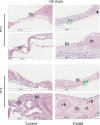P34HB electrospun fibres promote bone regeneration in vivo
- PMID: 30896076
- PMCID: PMC6536444
- DOI: 10.1111/cpr.12601
P34HB electrospun fibres promote bone regeneration in vivo
Abstract
Objective: Bone tissue engineering was introduced in 1995 and provides a new way to reconstruct bone and repair bone defects. However, the design and fabrication of suitable bionic bone scaffolds are still challenging, and the ideal scaffolds in bone tissue engineering should have a three-dimensional porous network, good biocompatibility, excellent biodegradability and so on. The purpose of our research was to investigate whether a bioplasticpoly3-hydroxybutyrate4-hydroxybutyrate (P34HB) electrospun fibre scaffold is conducive to the repair of bone defects, and whether it is a potential scaffold for bone tissue engineering.
Materials and methods: The P34HB electrospun fibre scaffolds were prepared by electrospinning technology, and the surface morphology, hydrophilicity, mechanical properties and cytological behaviour of the scaffolds were tested. Furthermore, a calvarial defect model was created in rats, and through layer-by-layer paper-stacking technology, the P34HB electrospun fibre scaffolds were implanted into the calvarial defect area and their effect on bone repair was evaluated.
Results: The results showed that the P34HB electrospun fibre scaffolds are interwoven with several fibres and have good porosity, physical properties and chemical properties and can promote cell adhesion and proliferation with no cytotoxicity in vitro. In addition, the P34HB electrospun fibre scaffolds can promote the repair of calvarial defects in vivo.
Conclusions: These results demonstrated that the P34HB electrospun fibre scaffold has a three-dimensional porous network with good biocompatibility, excellent biosafety and ability for bone regeneration and repair; thus, the P34HB electrospun fibre scaffold is a potential scaffold for bone tissue engineering.
Keywords: P34HB; bone marrow mesenchymal stem cells; bone tissue engineering; calvarial defects; electrospinning.
© 2019 The Authors. Cell Proliferation Published by John Wiley & Sons Ltd.© 2019 The Authors. Cell Proliferation Published by John Wiley & Sons Ltd.
Figures






Similar articles
-
Electrospun P34HB fibres: a scaffold for tissue engineering.Cell Prolif. 2014 Oct;47(5):465-75. doi: 10.1111/cpr.12122. Epub 2014 Aug 13. Cell Prolif. 2014. PMID: 25124858 Free PMC article.
-
Electrospun Poly(3-hydroxybutyrate-co-4-hydroxybutyrate)/Graphene Oxide Scaffold: Enhanced Properties and Promoted in Vivo Bone Repair in Rats.ACS Appl Mater Interfaces. 2017 Dec 13;9(49):42589-42600. doi: 10.1021/acsami.7b14267. Epub 2017 Nov 29. ACS Appl Mater Interfaces. 2017. PMID: 29148704
-
Electrospun porous poly(3-hydroxybutyrate-co-4-hydroxybutyrate)/lecithin scaffold for bone tissue engineering.RSC Adv. 2022 Apr 19;12(19):11913-11922. doi: 10.1039/d2ra01398c. eCollection 2022 Apr 13. RSC Adv. 2022. PMID: 35481079 Free PMC article.
-
Application and Development of Electrospun Nanofiber Scaffolds for Bone Tissue Engineering.ACS Biomater Sci Eng. 2024 Jul 8;10(7):4114-4144. doi: 10.1021/acsbiomaterials.4c00028. Epub 2024 Jun 3. ACS Biomater Sci Eng. 2024. PMID: 38830819 Review.
-
A Review on Advances and Challenges in Core-Shell Scaffolds for Bone Tissue Engineering: Design, Fabrication, and Clinical Translation.Macromol Rapid Commun. 2025 Jul;46(13):e2400620. doi: 10.1002/marc.202400620. Epub 2024 Nov 3. Macromol Rapid Commun. 2025. PMID: 39489721 Review.
Cited by
-
Surface-Modified Highly Biocompatible Bacterial-poly(3-hydroxybutyrate-co-4-hydroxybutyrate): A Review on the Promising Next-Generation Biomaterial.Polymers (Basel). 2020 Dec 25;13(1):51. doi: 10.3390/polym13010051. Polymers (Basel). 2020. PMID: 33375622 Free PMC article. Review.
-
Elastomeric Polyesters in Cardiovascular Tissue Engineering and Organs-on-a-Chip.Biomacromolecules. 2023 Nov 13;24(11):4511-4531. doi: 10.1021/acs.biomac.3c00387. Epub 2023 Aug 28. Biomacromolecules. 2023. PMID: 37639715 Free PMC article. Review.
-
Role of Fzd6 in Regulating the Osteogenic Differentiation of Adipose-derived Stem Cells in Osteoporotic Mice.Stem Cell Rev Rep. 2021 Oct;17(5):1889-1904. doi: 10.1007/s12015-021-10182-2. Epub 2021 May 26. Stem Cell Rev Rep. 2021. PMID: 34041696
-
Biomedical Applications of Polyhydroxyalkanoate in Tissue Engineering.Polymers (Basel). 2022 May 24;14(11):2141. doi: 10.3390/polym14112141. Polymers (Basel). 2022. PMID: 35683815 Free PMC article. Review.
-
Melt Electrowriting of Polyhydroxyalkanoates for Enzymatically Degradable Scaffolds.Adv Healthc Mater. 2025 Mar;14(6):e2401504. doi: 10.1002/adhm.202401504. Epub 2024 Nov 12. Adv Healthc Mater. 2025. PMID: 39533454 Free PMC article.
References
-
- Petite H, Viateau V, Bensaïd W, et al. Tissue‐engineered bone regeneration. Nat Biotechnol. 2000;18:959‐963. - PubMed
-
- Wang H, Li Y, Zuo Y, Li J, Ma S, Cheng L. Biocompatibility and osteogenesis of biomimetic nano‐hydroxyapatite/polyamide composite scaffolds for bone tissue engineering. Biomaterials. 2007;28:3338‐3348. - PubMed
-
- Stevens MM. Biomaterials for bone tissue engineering. Mater Today. 2008;11:18‐25.
-
- Bran GM, Stern‐Straeter J, Hörmann K, Riedel F, Goessler UR. Apoptosis in bone for tissue engineering. Arch Med Res. 2008;39:467‐482. - PubMed
-
- Cancedda R, Giannoni P, Mastrogiacomo M. A tissue engineering approach to bone repair in large animal models and in clinical practice. Biomaterials. 2007;28:4240‐4250. - PubMed
MeSH terms
Substances
Grants and funding
LinkOut - more resources
Full Text Sources
Other Literature Sources

